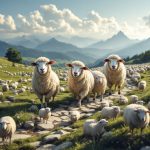
Shattered Fortunes: Unveiling the 1987 Stock Market Crash
Dec 15, 2024
The spectre of a “Black Monday” type event looms perennially over the markets, reminding us that unpredictability is the only certainty in finance. Relying solely on the anticipation of market crashes, akin to putting all your eggs in one basket, defies the foundational principles of diversified investment strategies.
Historically, despite the occasional crashes, markets have predominantly exhibited bullish behaviour. Focusing on the growth potential is more pragmatic than fixating solely on the risks of downturns. However, prudence dictates that investors should avoid excessive risks and remain vigilant.
A strategic approach involves buying amidst fear and pessimism—when the market’s blood runs cold—and selling during peaks of optimism and excitement. This contrarian strategy aligns with historical market sentiment patterns, often providing early signals for those attentive to the market’s mood.
Understanding the dynamics of mass psychology is crucial. The market reflects collective human emotions—greed, fear, hope, and despair—all playing out on the grand stage of the trading floors. The 1987 crash, like others before and after, was not just a financial phenomenon but a psychological one. The reforms that followed, such as introducing circuit breakers and more robust market liquidity measures, underscore the lessons learned in managing such crises.
The Black Monday crash is a stark reminder of the inherent risks and opportunities in the stock market. It’s a historical point emphasising the importance of readiness and the ability to adapt to rapid changes in market conditions. By studying these events, investors can better prepare themselves to mitigate risks and capitalize on the opportunities that arise from such market disruptions.
From Boom to Bust: Navigating the 1987 Crash and Beyond
The 1987 stock market crash is a stark reminder of financial markets’ inherent unpredictability. This event, like others before and after it, exposed the fallibility of experts and the media’s propensity for sensationalism. While they hype crashes and stoke fears, the savvy investor recognizes these as opportunities to buy while prices are low.
The game remains the same, regardless of who occupies the White House. The power brokers control the fiat money system, pulling the strings behind the scenes. They manipulate the masses through fear, creating an illusion of freedom where decisions are limited to those that don’t threaten their control.
The Tactical Investor takes a pragmatic approach, focusing on reality and identifying trends. We recognize that market crashes are inevitable but also opportunities for those with a long-term perspective. The markets may experience severe corrections, but the overall trajectory remains upward.
As the Austrian business cycle theory suggests, credit-fueled booms inevitably lead to busts. However, this is not cause for panic but a strategic moment to buy. The significant crashes of 2000, 2008, and 2020 are reminders that market corrections are a natural part of the economic cycle. Those who learn from history avoid the herd mentality and make informed decisions.
In Mark Twain’s words, “History doesn’t repeat itself, but it often rhymes.” The patterns of market behaviour are predictable, and fear is a constant tool used by those in power. We must view fear as an opportunity, not a threat. By understanding the dynamics of market psychology, we can march to our drumbeat, seizing chances that others miss due to their reactive nature.
So, let the media play its tune, and the experts bray. We navigate the financial circus with a clear view, knowing that opportunity lies beyond the noise. The 1987 crash is a testament to the resilience of the markets and a reminder to focus on the long game, for that is where true wealth is built.
Riding the Waves: Seizing Opportunity Amidst Market Turmoil
Oh, how the tides of fortune favour the brave and the farsighted! The market’s storms—Black Monday in 1987 or the COVID-crash of 2020—are not harbingers of ruin for all. For the resolute, they are clarion calls to action. These moments of chaos are the crucibles in which wealth is forged, not lost. To hesitate is to drift aimlessly; to act is to ride the crest of history itself.
Witness the clarity of corporate insiders during 2020, whose unprecedented buying frenzy transformed the sell-to-buy ratio into a mere 0.35—a powerful signal that behind the public panic lay private conviction. These industry titans saw not a collapse but an opening, their actions underscoring the ancient truth: courage in the face of chaos separates the profiteer from the pessimist.
Look further to the pantheon of investment greats, individuals whose names are synonymous with seizing opportunity amidst the storm. In the darkest days, the so-called Oracle of Omaha reminded us that gold rains hardest when the skies seem darkest. Meanwhile, visionaries like Cathie Wood bet not on fleeting trends but on transformative shifts, banking on humanity’s relentless drive toward innovation even as the rest of the market froze.
Across the global stage, the drama unfolds. Political tremors may unsettle, yet they also redraw the map of prosperity. With its meteoric rise, Asia presents a dynamic contrast to other regions weighed down by stagnation or discord. For those attuned to the symphony of economic growth, new chords of opportunity resonate—rich, bold, and waiting to be claimed.
The choice is stark but simple: view volatility as doom or see it for what it truly is—a tempest that clears the way for those ready to build anew. To act with conviction is to shape one’s destiny; to falter is to consign oneself to history’s sidelines.
The Farce of False Prophets: Charting Your Course Through Financial Folly
Friends and fellow stewards of wealth, let us peel back the curtain on the so-called experts who prophesy doom with every market tremor. Clad in the raiment of authority, they declaim with fervour, yet their words ring hollow, echoing the same tired refrains that have misled generations. They are the harbingers of hysteria, not grounded in wisdom but propelled by the winds of sensationalism.
Behold how the media amplifies their dire pronouncements! Sensational headlines scream from every corner, designed not to inform but to incite. They feast upon fear, for they know that a populace in panic is malleable, their reason overshadowed by emotion. Yet beneath this cacophony lies a simplicity they dare not acknowledge: markets are cyclical, and volatility is not a sign of ruin but a natural ebb and flow.
Let us not be swayed by these purveyors of panic! Recall the insights of Nobel laureate Richard Thaler, a behavioural economics pioneer who reminds us that human irrationality often influences markets. Yet more profound wisdom comes from Nathan Rothschild, the legendary 19th-century banker who made his fortune during the Battle of Waterloo. His immortal maxim, “Buy when there’s blood in the streets, even if the blood is your own,” exemplifies the courage to seize opportunity amid chaos.
Consider the sagacity of James J. Hill, the “Empire Builder” of the American Northwest, who built his railroad empire during the Panic of 1873. While others retreated, Hill recognized that economic downturns presented rare opportunities to acquire assets at favourable prices. His strategic acumen during crises demonstrated that true wealth is built not by following the crowd but by maintaining clear judgment when others succumb to fear.
When others rush to abandon ship at the first sign of squalls, we shall hold firm, knowing that turbulence also brings opportunity. Disregard the clamour of those who peddle fear for their gain. Instead, listen to the clarion call of reason and the counsel of those whose insights are forged in experience and intellect.
Opportunity does not shout from the mountaintops; it often whispers in the quiet moments when others have ceased to listen. In these moments, fortunes are made, and history favours those who act not out of fear but with boldness and clarity of purpose.
Unraveling Market Crashes: Lessons from 1987, 2020, and Beyond
The untrained eye sees only catastrophe in the grand spectacle of market crashes. Still, the astute observer discerns a thrilling invitation—a chance to conquer the chaos and emerge richer, sharper, and unshackled from mediocrity. From Black Monday in 1987 to the 2020 COVID-driven freefall, history repeatedly teaches the same fierce lesson: the heart of a market crash beats not with despair but with opportunity for those bold enough to dance in the storm.
Take the infamous dot-com bubble of the late 1990s, where exuberance ballooned into delusion as investors hurled billions at companies with laughable fundamentals. When the bubble burst, fortunes evaporated overnight, yet for those with vision, it was a goldmine. Battered but unbroken, Amazon emerged as a behemoth because those with conviction dared to believe in its intrinsic value.
Fast-forward to 2020: as the world locked down, markets spiraled, and panic reigned, insiders turned the tide. With a sell-to-buy ratio of 0.35—a battle cry of corporate faith—CEOs and board members laid their bets not on doom but on recovery. This wasn’t blind optimism; it was calculated defiance. History whispered its perennial truth: when fear swells, the price of opportunity plummets.
Consider the housing bubble of 2008, a perfect storm of reckless lending and misplaced faith in ever-rising property values. Its collapse sent markets into freefall, yet those who braved the wreckage—snapping up undervalued assets—built the foundations of generational wealth.
To act amidst calamity is no romantic notion but a necessity. The Federal Reserve’s interventions during the COVID crash showed how markets, however wounded, always tend toward recovery. Liquidity injections, lending facilities, and stimulus measures are the lifeboats of modern crises, creating fertile ground for those ready to sow.
The wisdom of investment titans—Templeton, Munger, and their ilk—rings louder than ever in this hyperconnected age. “Be greedy when others are fearful” isn’t mere rhetoric; it’s a mantra for those ready to dominate the field where others tremble. The time to buy is when markets bleed red, and headlines wail despair.
So, let others quiver at the thought of another crash. The informed, the prepared, the audacious—they see such moments not as tragedy but as the rarest of gifts. Whether it’s the next tech bubble, a geopolitical tremor, or some unforeseen calamity, the opportunity remains eternal for those brave enough to seize it.
Conclusion: Market Crashes Are Buying Opportunities
Market crashes have historically been viewed as times of fear and panic, but they can also buy opportunities for savvy investors who keep a cool head and follow the market’s trends. The key is to use mass psychology to understand sentiment dynamics and identify early warning signs. By staying disciplined and focusing on the trend, investors can achieve long-term success and turn market crashes into buying opportunities.
In conclusion, Fugger, Templeton, and Munger’s wisdom provides a robust framework for turning market crises into opportunities. By studying these downturns through the lens of seasoned investors, one can gain the perspective needed to capitalize on the cyclical opportunities presented by the financial markets.
More Must-Reads: Compelling Articles You Don’t Want to Miss
Collective Behavior Generally Takes Which of the Following Forms?














